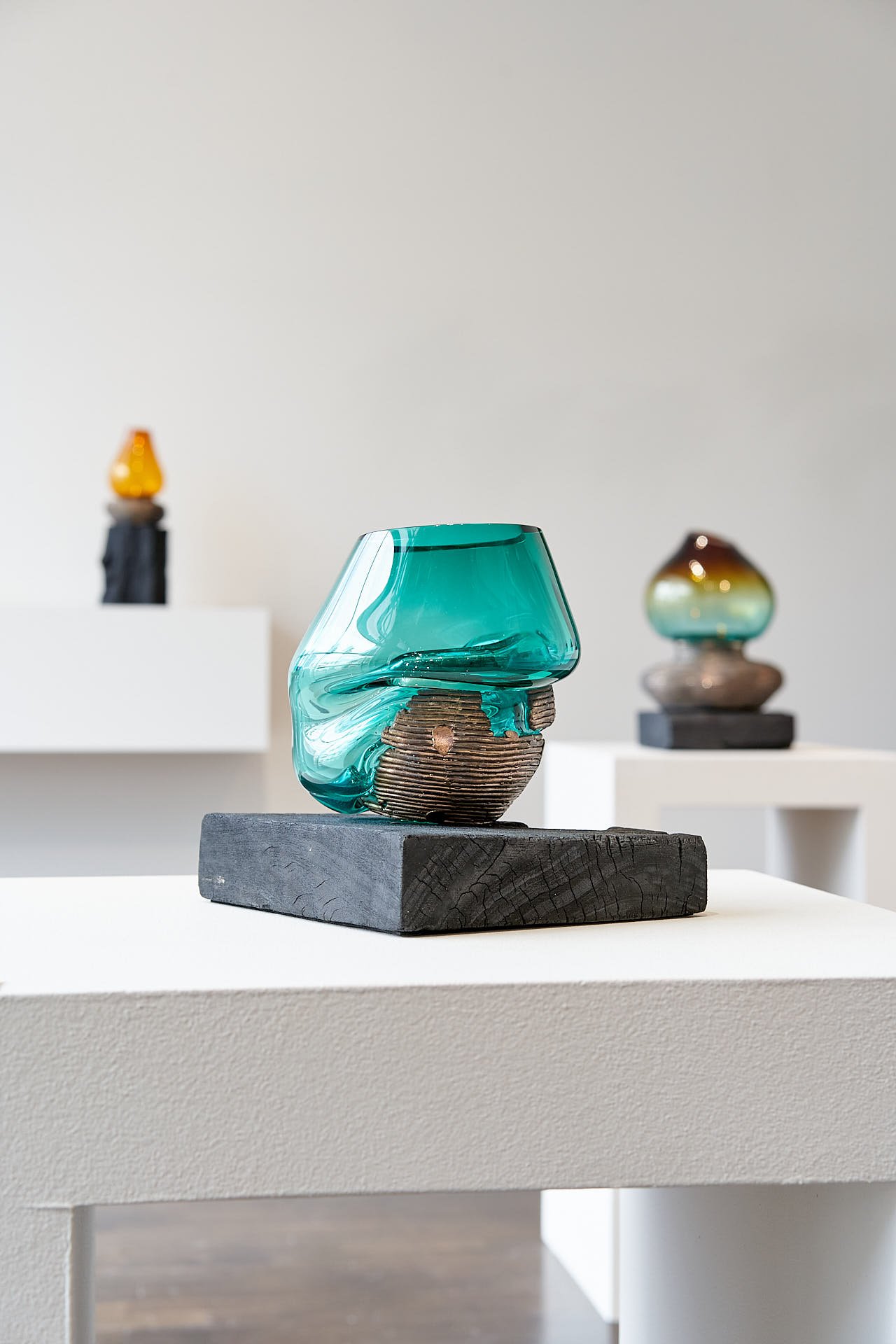Village Vessels (series 2)
2022
Exhibited at JamFactory Craft and Design Centre, Adelaide
“As vessels, the old metaphors of containment naturally abound. They provide opportunities to question divisions between inside and out, between the holder and the held and the seen and the secreted. But in the material duality of bronze and glass these metaphors are extended and complicated by notions of difference, resistance, legibility, and leakage that are made manifest in the material interactions of these objects. Seen at a distance they speak simply of cohabitation, of togetherness and separation, of glass and bronze. We know that, as a copper alloy, bronze shares a similar heating and cooling coefficient with glass and so they can marry together without the glass breaking. But seen at close proximity, at their points of contact, the nuance and complexity of the material conversation is revealed. There are moments of conformity and cooperation, discomfort, and contortion, and of tension and release.
These objects have taken on their forms for reasons of making. They possess a gestural immediacy. They express what materials do. They result from embodied research and intuitive process. What results is an intensified language of material and form that approximates poetry in three-dimensions and can then be read metaphorically. They are open to interpretation and should remain open. Like a poem, a multiplicity of meaning is the point. I won’t offer an interpretation for you. I encourage you all to relate poetically to this work and to feel and to dream your way through it. To allow it to reveal itself to you and in the process to find yourself also revealed.
What is worth further reflection, if not the meaning of things, is what these objects do. How do they affect the world of social relations for their maker and others? The title of this project, “Village Vessels” begs this question.
Anyone who knows Sarra will understand that the social is important to her. It’s a word that comes up a lot. Family and friendship seem inseparable from practice. Sarra and I share a foundational training in jewellery from which we have both extended our practices. Jewellery is an irretrievably social medium. In the early days of my practice, I would refer to jewellery as the home that one takes with them.
In observing Sarra across the development of this work I have come to understand that her practice too has resonance with notions of home. From an intercultural subjectivity to a need for physically embodied knowing I speculate that making for Sarra is a process of finding, making, and remaking her own place in the world. Creative practice may be a way of embodying, at a deep level, the human, material, and immaterial connections that constitute her social life.
What I see being made available through this work can be summed up under three broad orientations; firstly community: Village Vessels creates connections between local Adelaide arts and the Indian diaspora that can be seen, and should be celebrated, as part of a wider cosmopolitan localism.
Sarra’s practice might be understood as a kind of social innovation that expresses and sustains the diversity of local communities and their relations within a broader “worldmentality”. By embodying her heritage in and through contemporary practice, here and now and then and there combine in an inclusive geographic and temporal sensibility. In other words, making makes available to Sarra and others both her own cultural heritage as an Indian/Australian and a community of contemporary local practice.
Secondly material handling and haptic memory. There’s a visceral materiality that make available the processes of making and material response. The accidental and serendipitous has been encouraged, traces of the event of making remain visible, and critical restraint in finishing means that the materials themselves become more socially available. In one bronze miscast (which would be an error in any other context) the unintentionally open form has caused glass to spill, in what is best described as a complete and satisfying collapse of interior and exterior space. The gloss of blue glass somehow celebrating the chaos and complexity of its circumstance. In this way the objects reveal something of their own history, that often remains hidden.
And thirdly, there is a recurring interest in fire and the inhuman temperatures that create all three components of each object on show. The wooden plinth which has been fire hardened, a technique akin to what the Japanese call Shou-Sugi-Ban; the cast bronze that melts between 900 and 1000 degrees centigrade; only to be outdone by the glass furnace operating somewhere between 1 and 2 thousand degrees. Glassies, please feel free to jump in here to correct me. These inhuman temperatures prohibit the body from direct physical contact. Fire can only ever be inhabited in our imagination. Fire has long held associations with collective dreaming, potential destruction and, perhaps most relevant to this work the human quality of respect.
For me, these three orientations community, material handling and fire, combine in a powerful poetic that speaks of the entanglement of the human, of culture and technology, with material things and powerful immaterial forces of the world. In a manufactured world where these traces are often hidden, Village Vessels lay them bare and make them available for contemplation.
-Christian Hall











